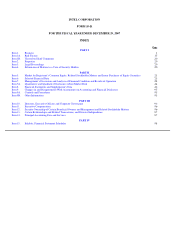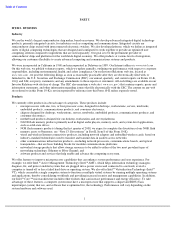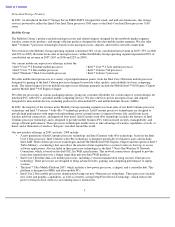Intel 2007 Annual Report Download - page 15
Download and view the complete annual report
Please find page 15 of the 2007 Intel annual report below. You can navigate through the pages in the report by either clicking on the pages listed below, or by using the keyword search tool below to find specific information within the annual report.
Table of Contents
Seasonal Trends
Our microprocessor sales generally have followed a seasonal trend; however, there can be no assurance that this trend will
continue. Historically, our sales of microprocessors have been higher in the second half of the year than in the first half of the
year. Consumer purchases of PCs have been higher in the second half of the year, primarily due to back
-to-school and holiday
demand. In addition, purchases from businesses have tended to be higher in the second half of the year.
Marketing
Our corporate marketing focus is on advanced multi-core microprocessors. Multi-core microprocessors are at the center of our
most advanced processor technologies, which include Intel Centrino processor technologies, Intel Core 2 processors with vPro
technology, and Intel Core 2 processors with Viiv technology. The Intel Core 2 Quad, Intel Core 2 Extreme, Intel Core 2 Duo,
Itanium, Intel Xeon, Pentium, and Celeron trademarks make up our processor brands. We promote brand awareness and
generate demand through our own direct marketing as well as co-marketing programs. Our direct marketing activities include
television, print and web-based advertising, as well as press relations, consumer and trade events, and industry and consumer
communications. We market to consumer and business audiences and focus on building awareness and generating demand for
increased performance, power efficiency, and new capabilities.
Purchases by customers often allow them to participate in cooperative advertising and marketing programs such as the Intel
Inside
®
program. This program broadens the reach of our brands beyond the scope of our own direct advertising. Through the
Intel Inside program, certain customers are licensed to place Intel logos on computers containing our microprocessors and
processor technologies, and to use our brands in marketing activities. The program includes a market development component
that accrues funds based on purchases and partially reimburses the OEMs for marketing activities for products featuring Intel
brands, subject to the OEMs meeting defined criteria. These marketing activities primarily include television, web-based
marketing, and print, and in the beginning of 2008, we increased our focus on web-
based marketing. We have also entered into
joint marketing arrangements with certain customers.
Competition
Our products compete primarily based on performance, features, price, quality, brand recognition, and availability. Our ability
to compete depends on our ability to provide innovative products and worldwide support for our customers at competitive
prices, including providing improved energy-efficient performance, enhanced security, manageability, and integrated
solutions. In addition to our various computing, networking, and communications products, we offer platforms that incorporate
various components designed and configured to work together to provide an optimized user computing solution compared to
ingredients that are used separately.
The semiconductor industry is characterized by rapid advances in technology and new product introductions. As unit volumes
of a particular product grow, production experience is accumulated and costs typically decrease, further competition develops,
and as a result, prices decline. The life cycle of our products is very short, sometimes less than a year. Our ability to compete
depends on our ability to improve our products and processes faster than our competitors, anticipate changing customer
requirements, and develop and launch new products and platforms, while reducing our average per-unit costs. See “Risk
Factors” in Part I, Item 1A of this Form 10-K.
Many companies compete with us in the various computing, networking, and communications market segments, and are
engaged in the same basic business activities, including R&D. Worldwide, these competitors range in size from large
established multinational companies with multiple product lines to smaller companies and new entrants to the marketplace that
compete in specialized market segments. Some of our competitors may have development agreements with other companies,
and in some cases our competitors may also be our customers and/or suppliers. Product offerings may cross over into multiple
product categories, offering us new opportunities but also resulting in more competition. It may be difficult for us to compete
in market segments where our competitors have established products and brand recognition.
10
























